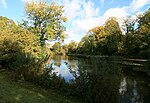Institut Sankt Joseph Copenhagen

Institut Sankt Joseph Copenhagen is a private, Catholic school located in Copenhagen, Denmark. The self-governing institution's formation ideals and daily activities are rooted in the Catholic-humanistic views on life and man. The school's primary aim is to develop thoughtful and caring students who take their lives, opportunities and choices seriously. The school's campus has a large main building with four floors, an annex building for kindergarten and after-school clubs, a theatre and a large gymnasium. The school is situated in the Østerbro section of Copenhagen, directly across from the United States Embassy and only minutes from the heart of the city and the coast.
Excerpt from the Wikipedia article Institut Sankt Joseph Copenhagen (License: CC BY-SA 3.0, Authors, Images).Institut Sankt Joseph Copenhagen
Dag Hammarskjölds Allé, Copenhagen Østerbro
Geographical coordinates (GPS) Address Nearby Places Show on map
Geographical coordinates (GPS)
| Latitude | Longitude |
|---|---|
| N 55.6942 ° | E 12.5819 ° |
Address
Dag Hammarskjölds Allé
1323 Copenhagen, Østerbro
Capital Region of Denmark, Denmark
Open on Google Maps










